Influence of Mining Sequence of Branch on Stope Pressure Behaviour on Continuous Mining and Continuous Backfilling
Abstract
1. Introduction
2. Branch Mining Sequence
3. Numerical Simulation of Mine Pressure Manifestation Law in CMCB Mining
3.1. Model Establishment and Calculation
3.2. Bearing Characteristics of Coal Pillar-Filling Body under Different Mining Sequences
4. Similarity Simulation of the Movement Law of Overburden in CMCB
4.1. Materials and Methods
4.2. Characteristics of Fissure Development and Overburden Movement Law under Different Mining Sequences
5. Engineering Application
5.1. Haoyuan Mine—Weak and Thick Coal Seam
5.2. Chahasu Mine—Solid Waste Disposal
6. Conclusions
Author Contributions
Funding
Data Availability Statement
Conflicts of Interest
References
- Yuan, L.; Zhang, P. Development status and prospect of geological guarantee technology for precise coal mining. J. China Coal Soc. 2019, 44, 2277–2284. [Google Scholar]
- Qian, M.; Xu, J.; Wang, J. Further on the sustainable mining of coal. J. China Coal Soc. 2018, 43, 1–13. [Google Scholar]
- Li, Q.; Li, X.; Xu, J.; Xu, Z.; Zhang, C. Research advances in mining fractures evolution law of rock strata and ecological treatment technology. Coal Sci. Technol. 2022, 50, 28–47. [Google Scholar] [CrossRef]
- Xie, H.; Ren, S.; Xie, Y.; Jiao, X. Development opportunities of the coal industry towards the goal of carbon neutrality. J. China Coal Soc. 2021, 46, 2197–2211. [Google Scholar]
- Liu, F.; Cao, W.; Zhang, J.; Cao, G.; Guo, L. Current technological innovation and development direction of the 14th Five-Year Plan period in China coal industry. J. China Coal Soc. 2021, 46, 1–15. [Google Scholar]
- Peng, S.; Bi, Y. Strategic consideration and core technology about environmental ecological restoration in coal mine areas in the Yellow River basin of China. J. China Coal Soc. 2020, 45, 1211–1221. [Google Scholar]
- Lin, H.; Yang, R.; Li, Y.; Lu, B.; Xu, B.; Fan, Z.; Li, J. Application of short-wall continuous mining and continuous backfilling cemented-fill mining technology. Chin. J. Eng. 2022, 44, 981–992. [Google Scholar]
- Xu, B.; Li, Y.; Lu, B.; Li, J. Three measurement relationship and control principle of overburden movement in cemented filling. J. China Coal Soc. 2022, 47, 1055–1071. [Google Scholar]
- Shao, X.; Tao, Y.; Liu, E.; Zhao, B.; Li, X.; Wang, L.; Li, L.; Tang, R.; Zhang, J. Study and application of paste-like filling mining parameters of shallow buried coal seam in Northern Shaanxi. Coal Sci. Technol. 2021, 49, 63–70. [Google Scholar]
- Wang, S.; Li, Y.; Li, Q.; Wang, Z.; Wang, Y. Influence of gangue gradation coefficient on the performance of filling material based on talbol theory. J. Min. Saf. Eng. 2022, 39, 683–692. [Google Scholar]
- Yang, B.; Han, Y.; Yang, P.; Li, Y. Research on Ratio of High Concentration Cementation Stowing Materials in Coal Mine. Coal Sci. Technol. 2014, 42, 30–33. [Google Scholar]
- Sun, Q.; Tian, S.; Sun, Q.; Li, B.; Cai, C.; Xia, Y.; Wei, X.; Mu, Q. Preparation and microstructure of fly ash geopolymer paste backfill material. J. Clean. Prod. 2019, 2, 376–390. [Google Scholar] [CrossRef]
- Huang, Y.; Duan, X.; Wang, Y.; Luo, H.; Hao, X. Research on non-full pipeline flow transportation and prevention method of coal gangue cemented backfill. Coal Sci. Technol. 2020, 48, 117–122. [Google Scholar]
- Li, B.; Zhang, J.; Yan, H.; Zhou, N.; Li, M. Experimental investigation into the thermal conductivity of gangue-cemented paste backfill in mine application. J. Mater. Res. Technol. 2022, 16, 1792–1802. [Google Scholar] [CrossRef]
- Ma, L.; Zhang, D.; Jin, Z.; Wang, S.; Yu, Y. Theories and methods of efficiency water conservation mining in short-distance coal seams. J. China Coal Soc. 2019, 44, 727–738. [Google Scholar]
- Lin, H.; Yang, R.; Lu, B.; Li, Y.; Fang, S.; Fan, Z.; Li, Z. Overlying strata movement law of continuous mining and continuous backfilling cemented-fill mining. Environ. Earth Sci. 2021, 80, 688. [Google Scholar] [CrossRef]
- Zhao, Y.; Ran, H.; Feng, G.; Guo, Y.; Fan, Y. Damage evolution and failure characteristics of cemented gangue backfill body with different height-width ratios under uniaxial compression. J. Min. Saf. Eng. 2022, 39, 674–682. [Google Scholar]
- Wu, J.; Jing, H.; Pu, H.; Zhang, X.; Meng, Q.; Yin, Q. Macroscopic and mesoscopic mechanical properties of cemented waste rock backfill using fractal gangue. Chin. J. Rock Mech. Eng. 2021, 40, 2083–2100. [Google Scholar]
- Wang, F.; Li, G.; Ban, J.; Peng, X.; Li, S.; Liu, S. Synergistic bearing effect of backfilling body and coal pillar in deep mining. J. Min. Saf. Eng. 2020, 37, 311–318. [Google Scholar]
- Zhang, Y.; Cao, S.; Guo, S.; Wan, T.; Wang, J. Study on the height of fractured water-conducting zone under aquifer for short wall blocking mining. J. Min. Saf. Eng. 2018, 35, 106–111. [Google Scholar]
- Cao, Z.; Xu, P.; Li, Z.; Zhang, M.; Zhao, Y.; Shen, W. Joint Bearing Mechanism of Coal Pillar and Backfilling Body in Roadway Backfilling Mining Technology. CMC—Comput. Mater. Contin. 2018, 54, 137–159. [Google Scholar]
- Deng, X.; Zhang, J.; Klein, B.; de Wit, B.; Zhang, J. Time-dependent lateral pressure of the filling barricade for roadway cemented backfill mining technology. Mech. Time-Depend. Mater. 2020, 24, 41–58. [Google Scholar] [CrossRef]
- Liang, X.; Ding, C.; Zhu, X.; Zhou, J.; Chen, C.; Guo, X. Visualization study on stress evolution and crack propagation of jointed rock mass under blasting load. Eng. Fract. Mech. 2024, 296, 109833. [Google Scholar] [CrossRef]
- Ye, Y.; Shi, Y.; Wang, Q.; Wang, Q.; Liu, Y.; Yao, N.; Lu, F. Experimental study of deformation of wall rock and stoping sequence in mining gently inclined and multilayer deposits by backfill mining. J. Min. Saf. Eng. 2015, 32, 407–413. [Google Scholar]
- Li, J.; Zhang, J.; Hou, J.; Wang, L.; Yin, Z.; Li, C. Multiple disturbance instability mechanism of dynamic pressure roadway and mining sequence optimization. J. Min. Saf. Eng. 2015, 32, 439–445. [Google Scholar]
- Wang, Y.; Cao, A.; Dou, L.; Guo, X.; Du, B.; Liu, H.; Zhu, L. Study on the Rock Burst Risk Caused by the Irrational Layout of the Mining Exploitation. J. Min. Saf. Eng. 2012, 29, 827–832. [Google Scholar]
- Hu, J.; Xi, Z.; Luo, X.; Zhou, K.; Ai, Z. Optimization of mining sequence based on rock mass time-varying mechanics parameters. J. Cent. South Univ. 2017, 48, 2759–2764. [Google Scholar]
- Lu, B.; Zhang, X.; Li, F.; Zhang, B.; Pang, Z. Study and application of short-wall gangue cemented backfilling technology. J. China Coal Soc. 2017, 42, 7–15. [Google Scholar]
- Tu, S.; Hao, D.; Li, W.; Liu, X.; Miao, K.; Yang, Z. Construction of the theory and technology system of selective mining in “mining, dressing, backfilling and X” integrated mine. J. Min. Saf. Eng. 2020, 37, 81–92. [Google Scholar]
- Liu, J.; Li, X.; He, T. Application status and prospect of backfill mining in Chinese coal mines. J. China Coal Soc. 2020, 45, 141–150. [Google Scholar]
- Guo, G.; Guo, K.; Zhang, G.; Li, H.; Hu, S. Research on deformation characteristics of coupled coal-backfills bearing in deep strip backfilling mining. J. Min. Saf. Eng. 2020, 37, 101–109. [Google Scholar]
- Lin, H.; Yang, R.; Li, Y.; Fang, S. Deformation Mechanism and Control Technology of Coal Roadway with Thin Sand-mudstone Interbed Roof. Min. Metall. Explor. 2022, 40, 421–433. [Google Scholar] [CrossRef]
- Zhou, N.; Xu, J.; Zhang, J.; Ma, D.; Li, Z.; Yao, Y. Study on the weaking mechanism of hard overburden rock burst disaster by backfilling. Chin. J. Rock Mech. Eng. 2023, 42, 2412–2426. [Google Scholar]
- Yu, L.; Luo, J.; Jia, C.; Yao, D.; Luo, J. Research on Application of Digital Image Correlation Method in Mechanical Property Test. Nucl. Power Eng. 2022, 43, 146–151. [Google Scholar]



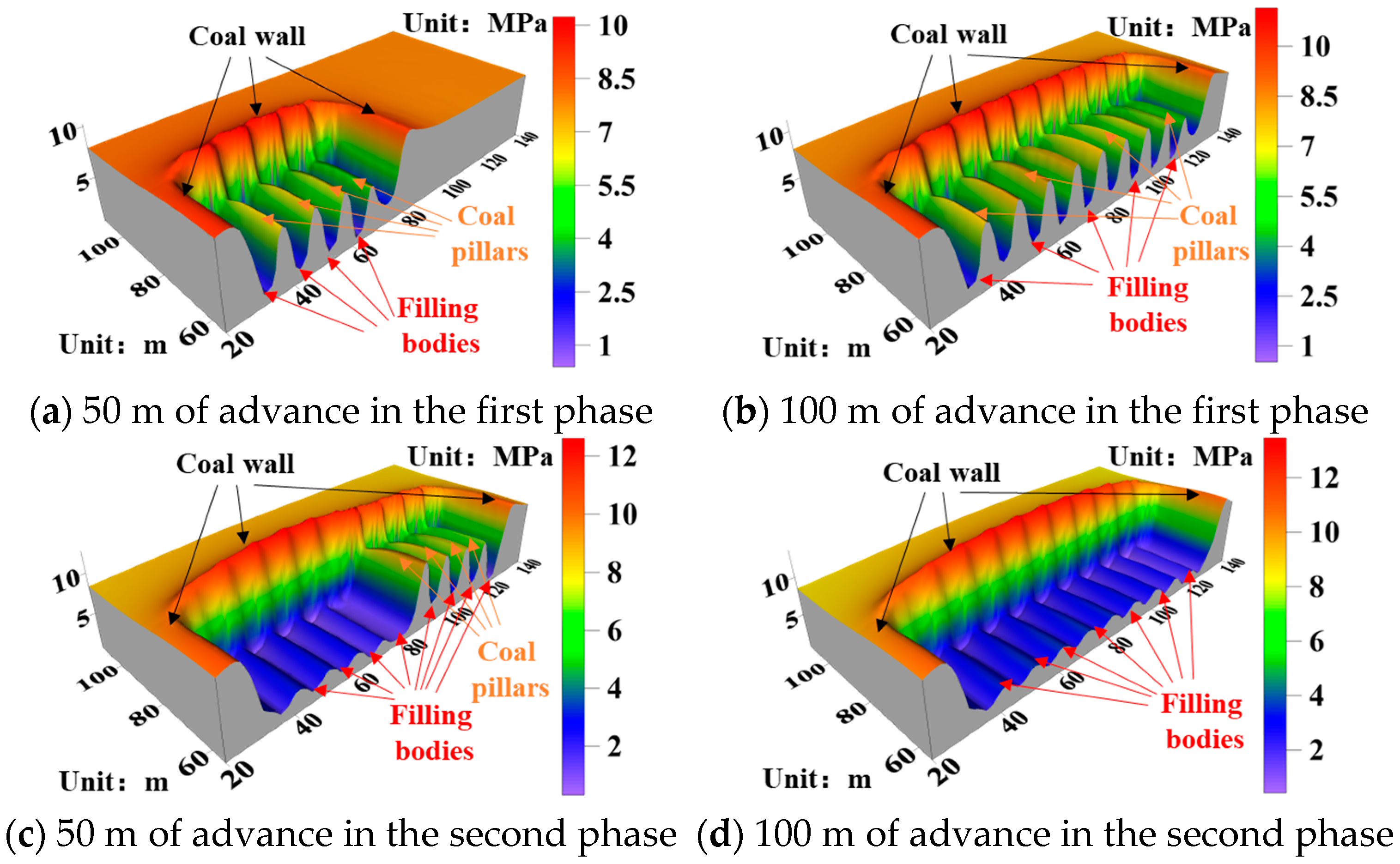

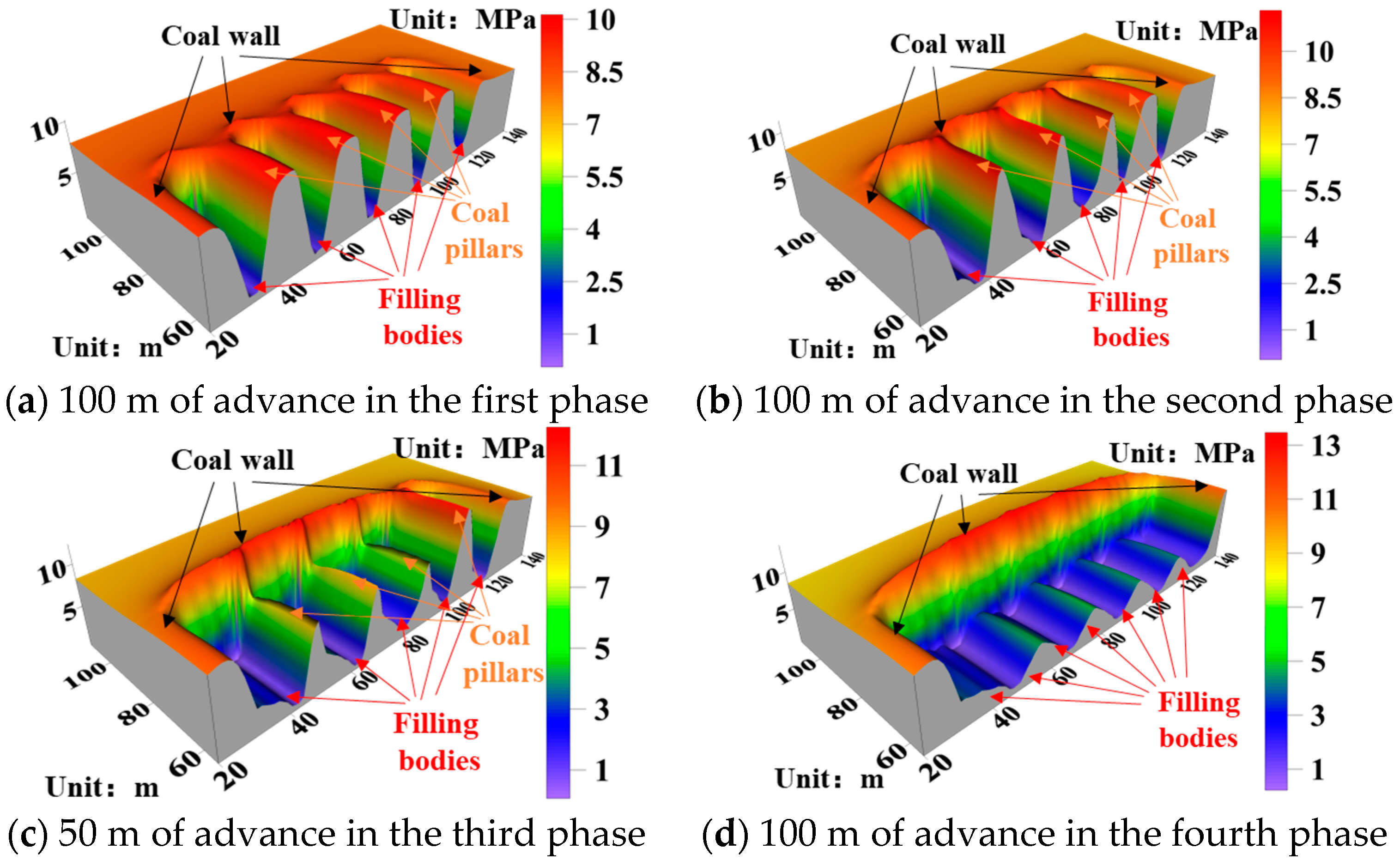

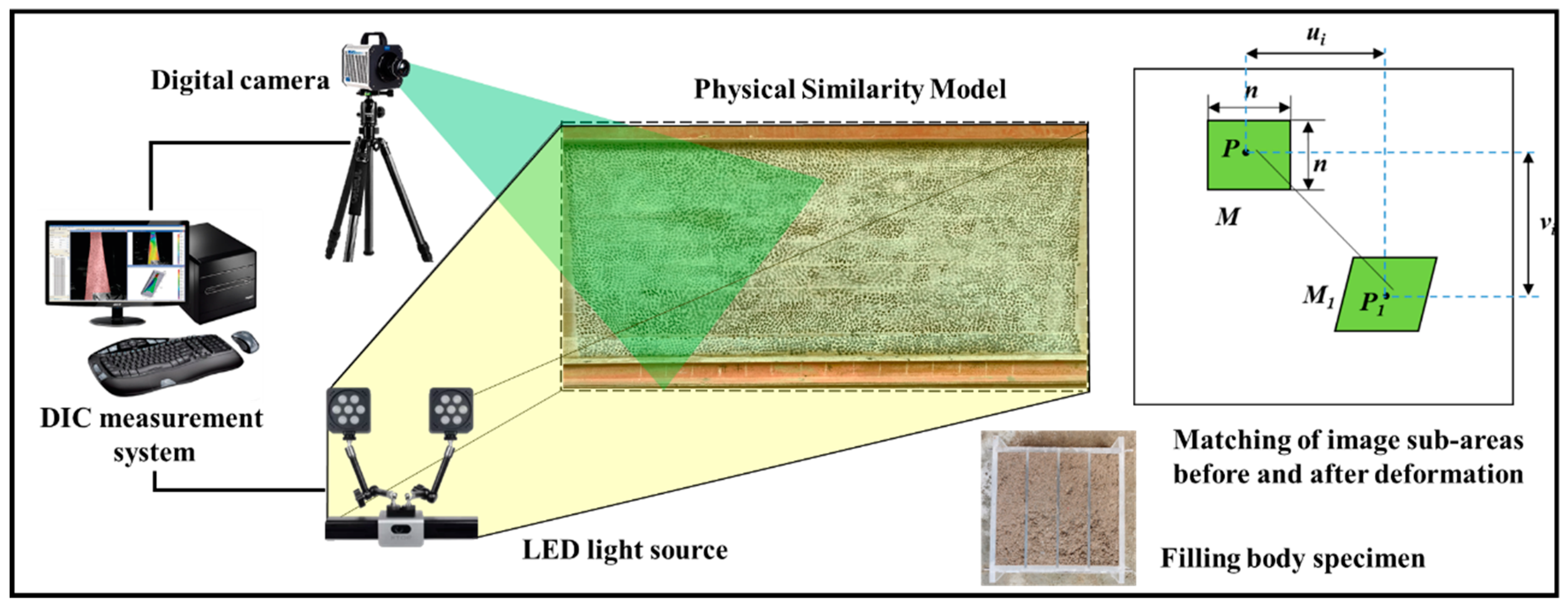

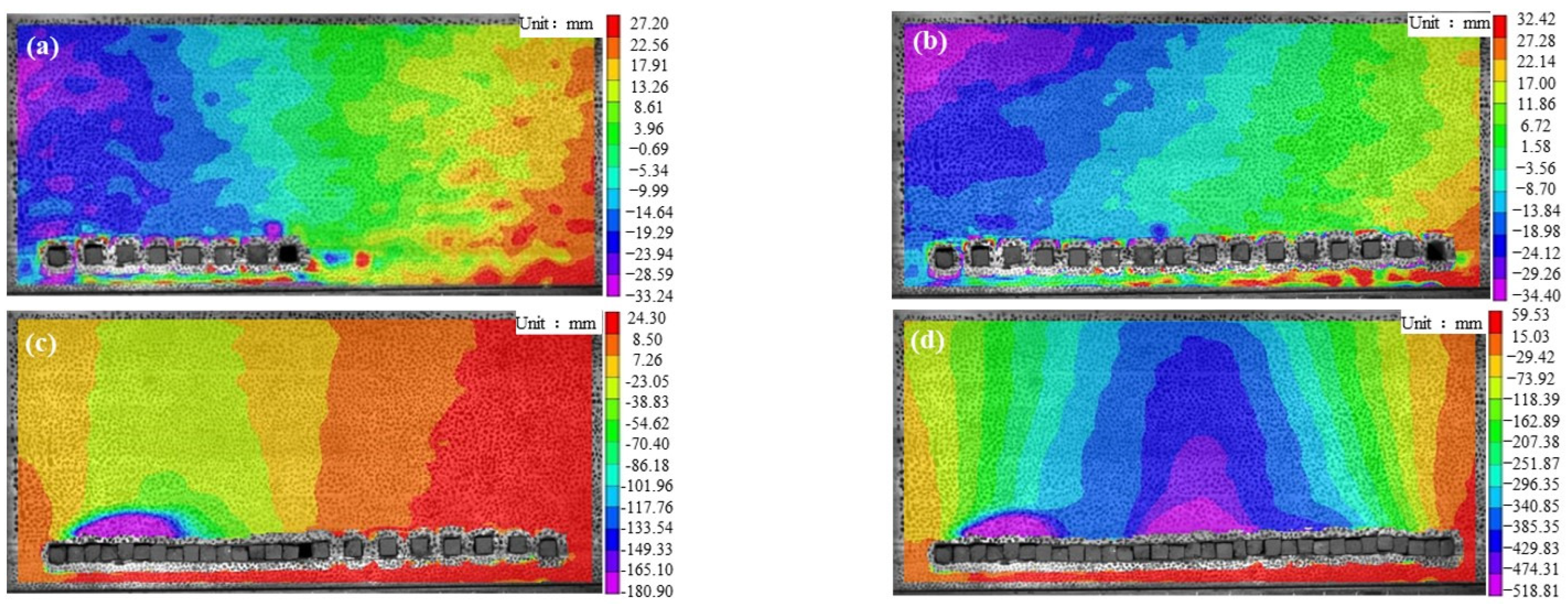
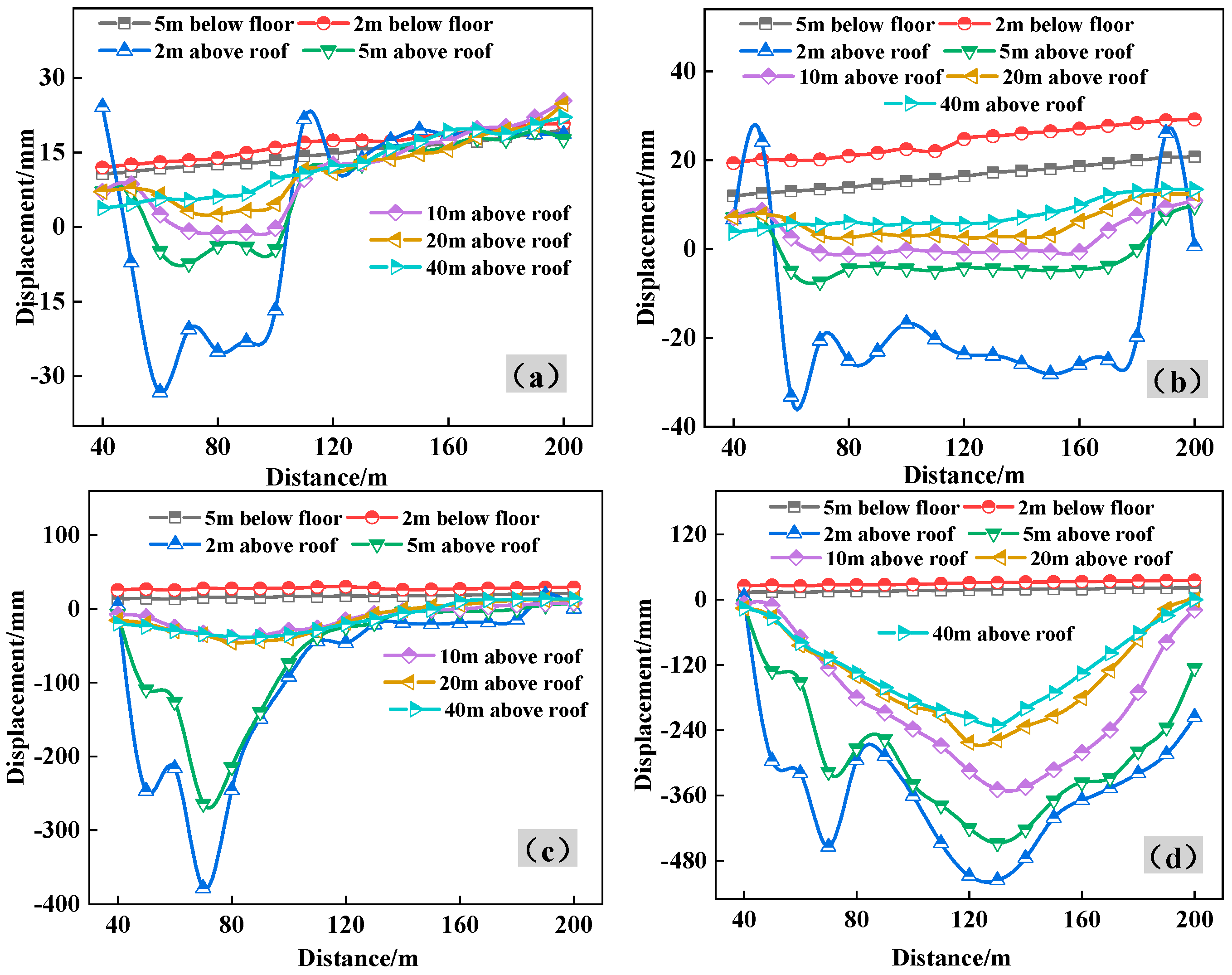
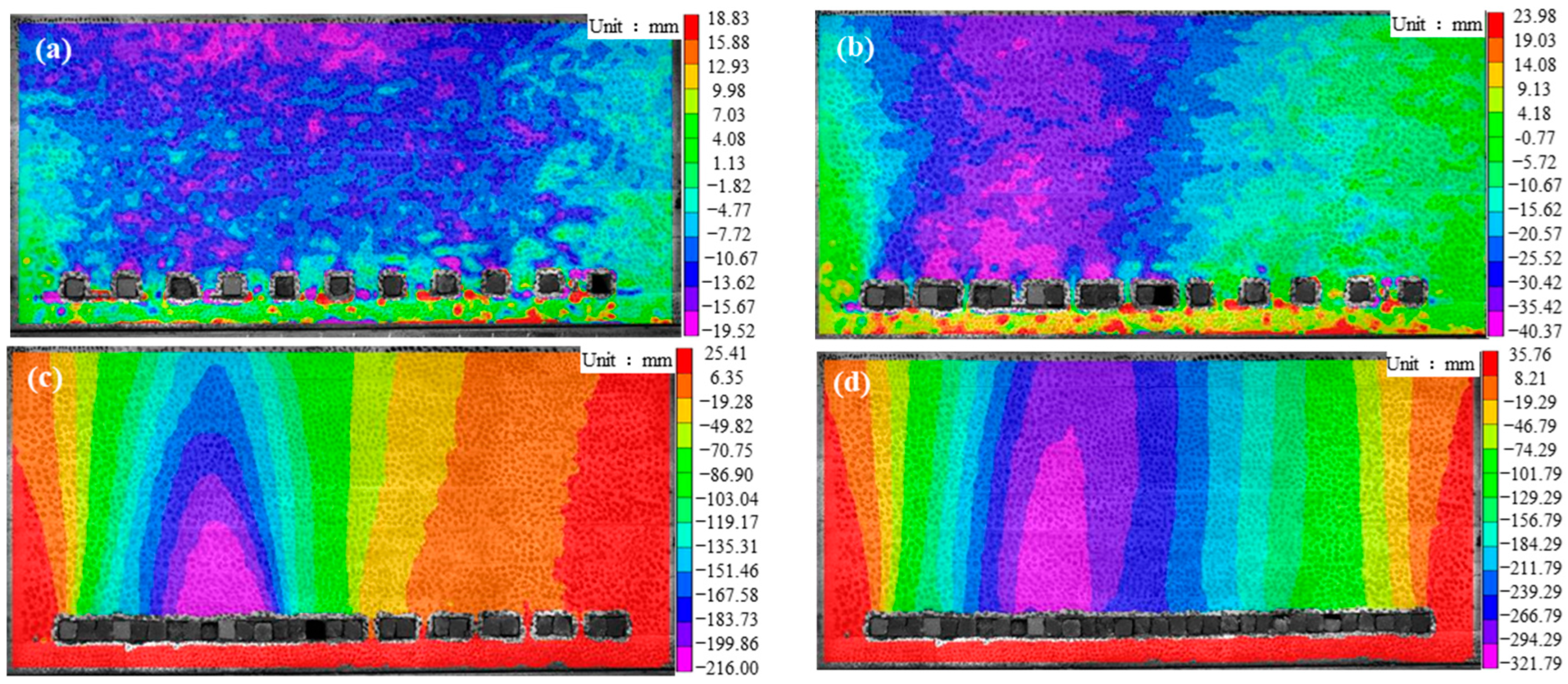

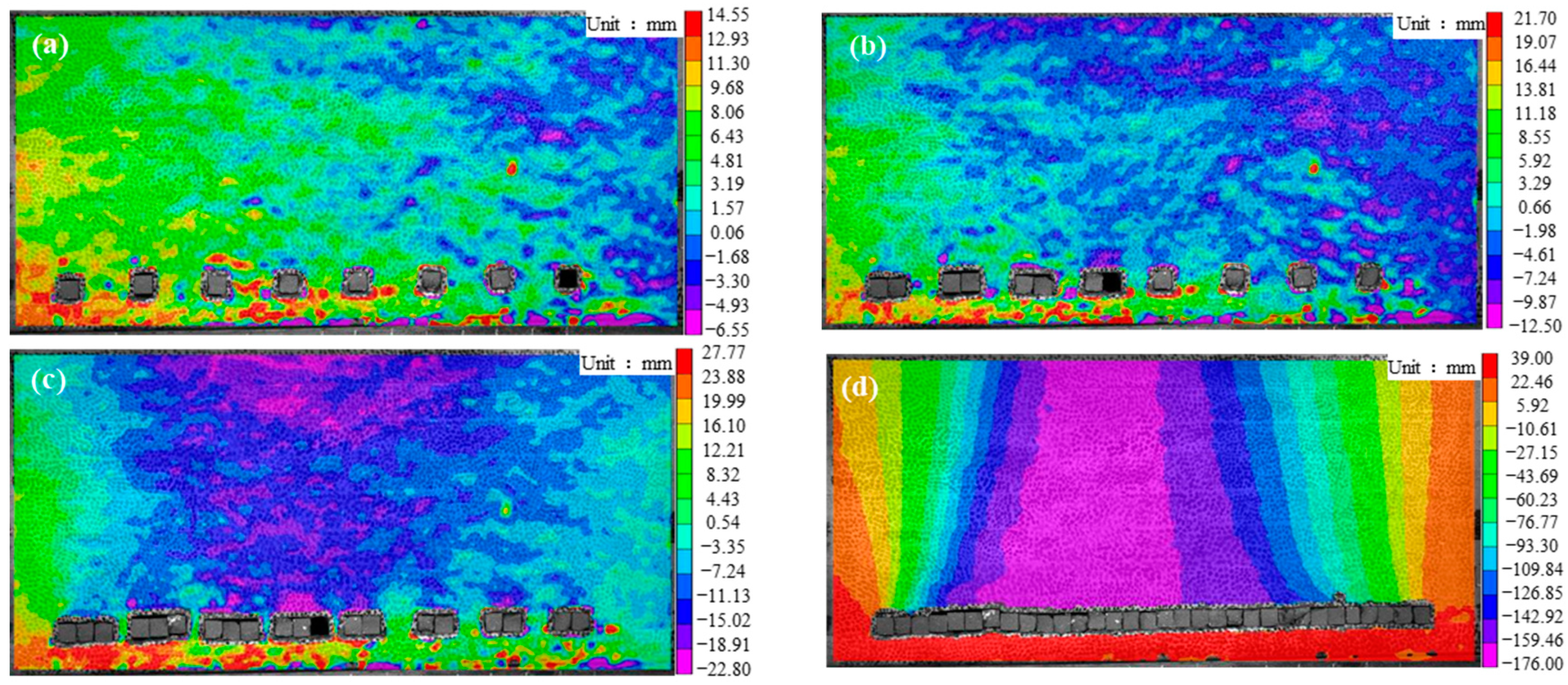
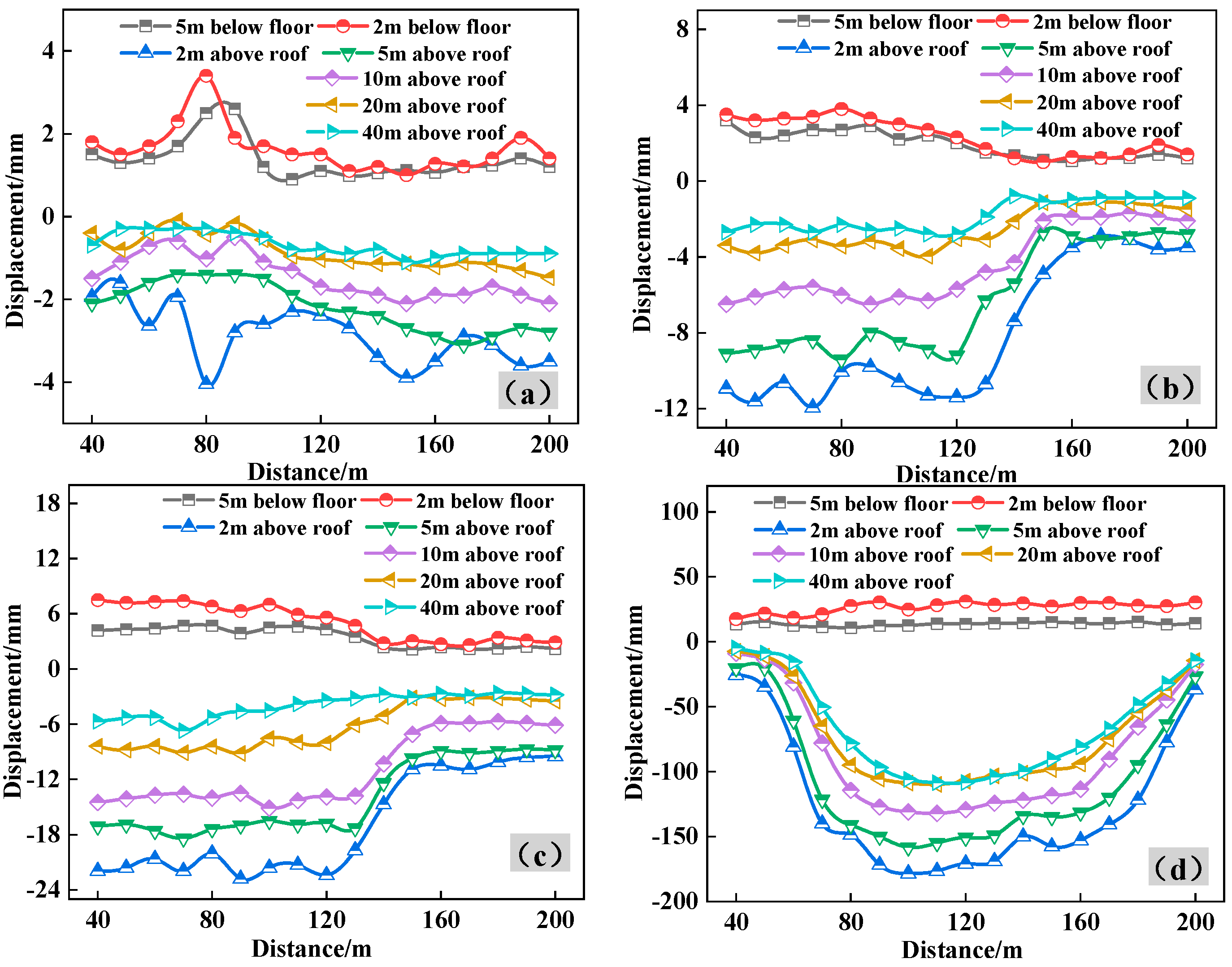
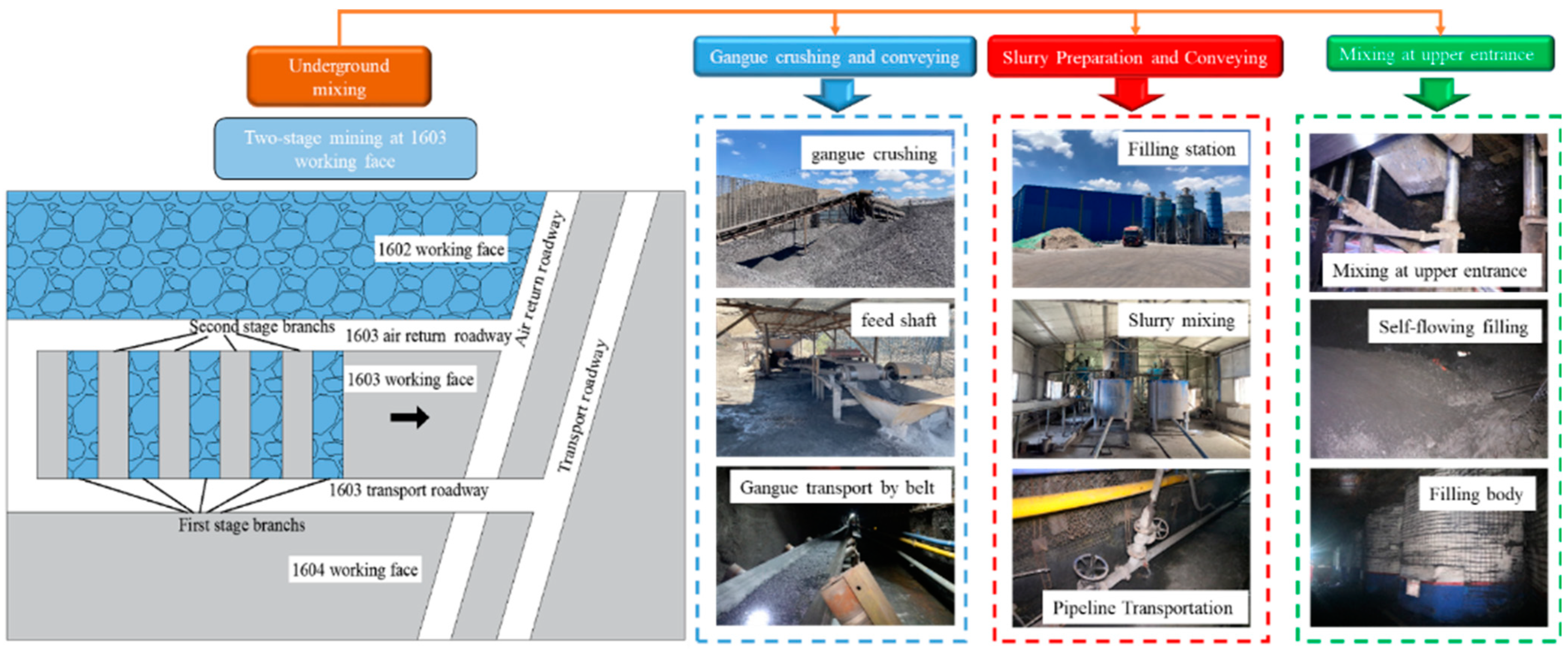



| Name | Production Capacities (MTA) | Extraction Stage | Width of Branch (m) | Name | Production Capacities (MTA) | Extraction Stage | Width of Branch (m) |
|---|---|---|---|---|---|---|---|
| Yuxing mine | 0.6 | two | 5 | Xinjulong mine | 7.5 | two | 4.5 |
| Haoyuan mine | 0.6 | two | 5 | Yiqiao mine | 0.8 | two | 4.5 |
| Huangbaici mine | 1.2 | two | 5 | Xincun mine | 0.9 | four | 5 |
| Limin mine | 1.8 | three | 5 | Wangtaipu mine | 2.6 | four | 6 |
| Wuhushan mine | 2.0 | two | 5 | Qianwan mine | 0.9 | two | 5 |
| Changcheng fifth mine | 1.8 | two | 4 | Xinjian mine | 1.2 | two | 4 |
| Changcheng sixth mine (plan) | 1.5 | — | — | Zishen mine | 0.9 | two | 5 |
| Tianyu mine | 0.6 | two | 5 | Xinzhi mine | 0.28 | two | 5 |
| Gonggeyingzi mine | 0.3 | three | 4 | Changcun mine | 8.0 | four | 5 |
| Gongwusu mine (plan) | 2.7 | — | — | Dianpin mine | 2.6 | two | 6 |
| Chahasu mine | 10.0 | three/four | 5 | Sihe mine | 1.8 | two | 6 |
| Dingjiaqu (plan) | 2.3 | — | — | Sima mine | 3.0 | two | 5 |
| Huhewusu mine | 1.2 | three | 5 | Dongshan mine | 1.5 | four | 5 |
| Guanbanwusu mine (plan) | 2.4 | — | — | Yachen mine (plan) | 0.6 | — | — |
| Suncun mine | 0.6 | two | 5 | Sucun mine (plan) | 0.9 | — | — |
| Gaozhuang mine (plan) | 3.6 | — | — | Changxing mine | 0.9 | two | 6 |
| Zhaizheng mine | 2.0 | two | 4.5 | Yuyang mine | 3.0 | two | 5.4 |
| Xiezhuang mine | 2.0 | two | 5 | Guojiawan mine (plan) | 2.1 | — | — |
| Lithology | Density/kg/m3 | Bulk Modulus/GPa | Shear Modulus/GPa | Cohesion/MPa | Angle of Internal/° | Tensile Strength/MPa |
|---|---|---|---|---|---|---|
| Sandy mudstone | 2550 | 3.6 | 2.1 | 2.52 | 29 | 2.5 |
| Mudstone | 2200 | 5.4 | 4.8 | 2.6 | 24 | 2.2 |
| Coal | 1400 | 1.27 | 0.43 | 1.9 | 25 | 1.2 |
| Fine sandstone | 2600 | 10 | 7.5 | 6.5 | 32 | 3.2 |
| Medium sandstone | 2480 | 5.95 | 4.1 | 3 | 27 | 2.7 |
| Filling body | 1850 | 0.96 | 0.4 | 0.75 | 16 | 0.5 |
| No. | Lithology | Thickness (m) | Ratio | Material Consumption (kg) | |||
|---|---|---|---|---|---|---|---|
| Medium Sand | Lime | Gypsum | Water | ||||
| 12 | Sandy mudstone | 20 | 864 | 122.40 | 9.18 | 6.12 | 15.30 |
| 11 | Fine sandstone | 17 | 846 | 106.08 | 5.30 | 7.69 | 13.26 |
| 10 | Medium sandstone | 20 | 855 | 119.04 | 7.44 | 7.44 | 148.8 |
| 9 | Coal | 10 | 973 | 34.02 | 2.63 | 1.13 | 4.20 |
| 8 | Mudstone | 10 | 864 | 52.80 | 3.96 | 2.64 | 6.60 |
| 7 | Sandy mudstone | 6 | 864 | 36.72 | 2.75 | 1.84 | 4.59 |
| 6 | Fine sandstone | 8 | 846 | 42.43 | 2.12 | 3.08 | 5.30 |
| 5 | Interbed Sandy mudstone | 3 | 864 | 18.36 | 1.37 | 0.92 | 2.30 |
| 4 | Coal | 6 | 973 | 20.41 | 1.58 | 0.68 | 2.52 |
| 3 | Mudstone | 9 | 864 | 47.52 | 3.32 | 2.38 | 5.94 |
| 2 | Fine sandstone | 11 | 846 | 58.34 | 2.92 | 4.23 | 7.29 |
| 1 | Filling body | 6 | 846 | 26.64 | 2.00 | 1.33 | 3.33 |
Disclaimer/Publisher’s Note: The statements, opinions and data contained in all publications are solely those of the individual author(s) and contributor(s) and not of MDPI and/or the editor(s). MDPI and/or the editor(s) disclaim responsibility for any injury to people or property resulting from any ideas, methods, instructions or products referred to in the content. |
© 2024 by the authors. Licensee MDPI, Basel, Switzerland. This article is an open access article distributed under the terms and conditions of the Creative Commons Attribution (CC BY) license (https://creativecommons.org/licenses/by/4.0/).
Share and Cite
Lin, H.; Yang, Y.; Chen, C.; Ding, C. Influence of Mining Sequence of Branch on Stope Pressure Behaviour on Continuous Mining and Continuous Backfilling. Processes 2024, 12, 442. https://doi.org/10.3390/pr12030442
Lin H, Yang Y, Chen C, Ding C. Influence of Mining Sequence of Branch on Stope Pressure Behaviour on Continuous Mining and Continuous Backfilling. Processes. 2024; 12(3):442. https://doi.org/10.3390/pr12030442
Chicago/Turabian StyleLin, Hai, Yang Yang, Cheng Chen, and Chenxi Ding. 2024. "Influence of Mining Sequence of Branch on Stope Pressure Behaviour on Continuous Mining and Continuous Backfilling" Processes 12, no. 3: 442. https://doi.org/10.3390/pr12030442
APA StyleLin, H., Yang, Y., Chen, C., & Ding, C. (2024). Influence of Mining Sequence of Branch on Stope Pressure Behaviour on Continuous Mining and Continuous Backfilling. Processes, 12(3), 442. https://doi.org/10.3390/pr12030442







